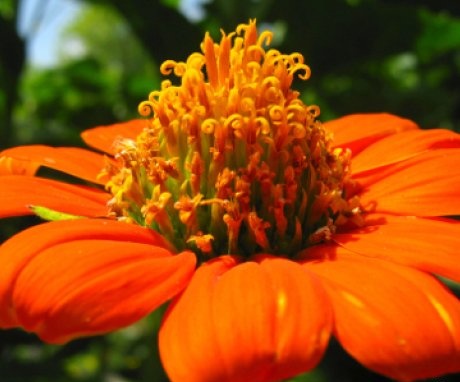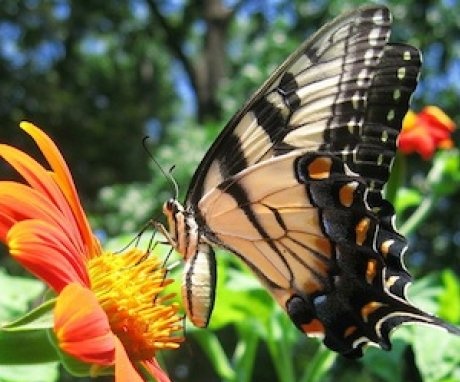How to grow a Tithonia flower
Many plants, which are traditionally residents of not only other countries, but even other continents, have become beloved in our country. Unfortunately, many of the beautifully flowering plants are not yet very popular here, in Russia. For example, the titonia flower.
Content:
- The origin of the flower
- Description of titonia
- Reproduction
- Titonia - a flower for the lazy
- Seed collection
- Diseases and pests
- Application
The origin of the flower
This solar miracle hails from Central America, or rather from Mexico. And it was brought to Europe by the Spanish conquistadors. Actually, this flower is a perennial. But since he is a resident of warm countries, then in the conditions of central Russia he is grown as an annual plant.
Although those who have already tried to grow titonia on their site, they know that it can be planted in a large flowerpot, and with the onset of autumn, move it indoors and leave the titonia for the winter, waiting for the onset of a new spring.
Description of titonia
The plant belongs to the Asteraceae or Asteraceae family. There are 10 known types of titonia, but we grow only one - round-leaved titonia. It is not for nothing that botanists called it that: on reddish, slightly pubescent stems there are round leaves, the upper side of which is naked, and the lower side is silky-pubescent.
In appearance, titonia resembles sunflower, by the way, it is sometimes called that - Mexican sunflower. This plant is quite large, especially for a flower. In height, titonia can grow by 2 meters, as well as in width. A real bush, isn't it? And the flowers of Tithonia are also large - orange-red daisies 5-8 centimeters in diameter. They exude a light aroma and delight with their beauty from mid-summer to the first frost.
Reproduction
It is best to plant titonia with seedlings. It is planted at a distance of 50-150 centimeters.
The soil for titonia requires fertile and loose. In no case should water stagnation be allowed, as waterlogging can cause decay.
When the seedlings grow a little, it is recommended to pinch the plant over the 3rd or 4th leaf. This will help stimulate branching and give the flower a lush appearance.
Mulch is placed around the plant: humus, compost or grass. It will provide the roots with nutrients and keep the soil from drying out.
Her seeds are large, about 1 centimeter long, so it is very convenient to plant them each in a separate container filled with good fertile soil. You can sow seeds in the container. In this case, after the appearance of the fourth leaf, the seedlings are dived into peat cups.
The optimum temperature for germination is +18 degrees. Seedlings are shown half a month after sowing.
If titonia is planted directly on a flower bed, then it must be covered with a film, which can be completely removed only with the onset of stable heat.
Titonia - a flower for the lazy
Titonia is an ideal plant for lazy and novice gardeners. In care, she is absolutely undemanding - watering (minimal) and rare top dressing is all she needs. You should not get too carried away with fertilizing, otherwise titonia will grow lush foliage, but will not give flowers.
On fertile soil, fertilization is not required for the plant. But after the buds ripen, it is advisable to treat the leaves with an aqueous solution of trace elements. After such spraying, the flowers will become large and bright.
If the soil is poor, then it is recommended to make 3 top dressing per season:
- when the fourth leaf appears, fertilize the flower with a mullein;
- when buds begin to form, ash is used for feeding;
- during the flowering period, titonia is fertilized with mullein or complex fertilizers.
The Mexican sunflower loves light and warmth, so you need to find a place for it that is sunny, protected from the wind. It can easily endure even a slight drought and feels good at a time when other plants dry up and die.
In order for the flower to retain its decorative appearance, inflorescences that have faded are recommended to be removed.
Seed collection
Seeds of titonia must be collected when the flower itself turns brown. This must be done in a timely manner, otherwise the flowers will sow themselves, and in the cold winter they will simply disappear. The flowers are cut when they turn brown. Then they are placed in a single layer in a dry place to ripen the seeds. When the flower is completely dry, the seeds are cleaned and stored until the next planting season.
Diseases and pests
Pests and diseases rarely affect Mexican sunflowers. Young plants can be threatened by aphids and slug attacks. To get rid of aphids, a strong stream of water is sent to the plant, or it is treated with an alcohol solution of soap or an insecticide. You can also use a decoction wormwood, bow, tobacco, red capsicum or pine needles.
Application
Titonia looks great both singly and in group plantings. It can be used to make hedges or drape unsightly buildings. Her wonderful neighbors are peonies, chamomile and cochia... Mexican sunflower flowers are also suitable for making bouquets.













